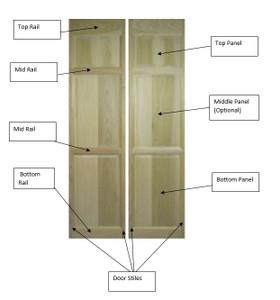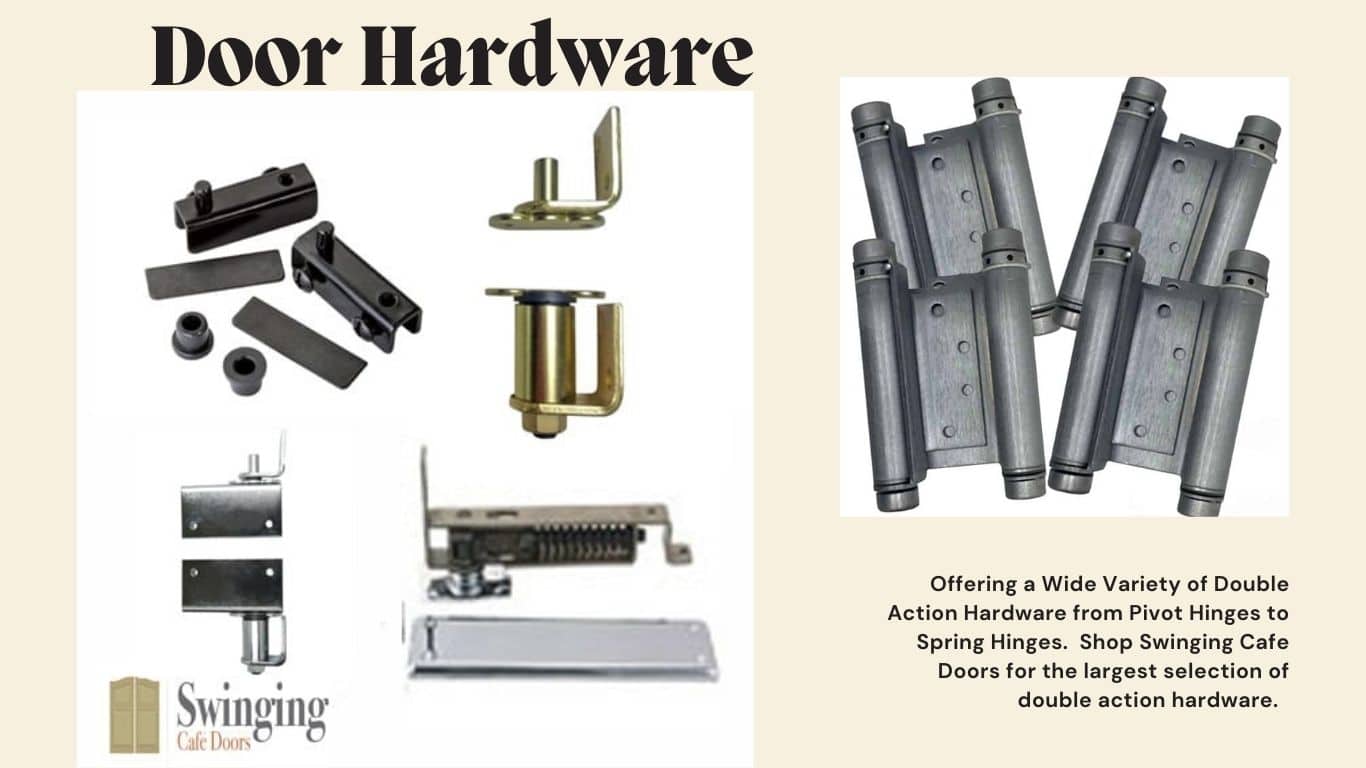
Parts of a Swinging Door
Parts of a Swinging Door
Ever walked through an old wooden swinging door and wondered how exactly the thing works? Those creaky doors with the little windows you see in Western movies seem simple enough, but there's actually more to them than meets the eye. You might not realize there are several components that come together to make the door swing open and close. Before you know it, you'll be seeing swinging doors in a whole new way.
In this article, we're going to take one of those saloon doors apart piece by piece so you understand what's really going on. By the end, you'll be a swinging door expert and might even want to build one of your own. So grab yourself a sarsaparilla, pull up a seat at the bar, and let's get started demystifying the parts of a swinging door.
Top, Mid & Bottom Rail
The top, middle and bottom rails are three of the most important parts of a swinging door. They provide structure and support, allowing the door to function properly.
Top Rail
The top rail is the horizontal piece at the very top of the door. It connects the two vertical stiles and stabilizes the entire door. The top rail bears much of the weight and stress on the door, so it needs to be securely attached to the stiles. It is also the place where many doors attach to the header above for additional support.
Mid Rail
The mid rail, as the name suggests, is the center horizontal rail in the middle of the door. Not all swinging doors have a mid rail, but for larger doors it helps prevent warping and sagging in the center. The mid rail also allows you to attach door panels, glass inserts or other decorative elements in the center of the door.
Bottom Rail
The bottom rail is the bottom horizontal piece that connects the two stiles. It helps keep the bottom of the door square and prevents the stiles from splaying outward. The bottom rail includes a groove or channel where the bottom edge of the door panels or inserts fit. It may also have a lip or edge to hold weatherstripping or a door sweep in place along the bottom.
The placement and size of the top, mid and bottom rails depends on the overall size and weight of the door. Heavier doors require more and sturdier rails to provide adequate support and prevent the door from becoming misshapen over time. The rails, along with the stiles, create the basic backbone and geometry of a swinging door. They are simple but integral parts that allow the door to function as a whole.

Door Stiles
A door stile refers to the vertical or upright components of a door frame. There are typically two stiles in a door frame one on the hinge side and the other on the latch side. These stiles provide structural support to the door and contribute to its overall stability. The horizontal components of the door frame are called rails. The stiles and rails together form the framework of the door, and they can vary in design and thickness depending on the type and style of the door.
Some door design can have a mid stile to add addition stability, mid stile are using in door opening over 55" wide for double doors on most of our panel door designs.
The Door Panels - The Main Body
The door panel is the largest, central part of a swinging door. It's what gives the door its shape and size. The panel sits within the door frame and is attached to the hinges, allowing it to swing open and closed.
Core Materials
The panel's core material fills the space between the two "skins" or faces of the door. Solid core doors are recommended for swinging doors, the solid cores include:
● Solid wood - A solid wood core, like the door's face material, gives maximum durability, security and insulation. Most expensive option.
● MDF material - wood composite best for painting, strong yet easy paintable surface gives durability, security and insulation.
The door panel, with all its options for materials, cores, and sizes, provides the customization needed for an entryway in any home or building. By understanding the components and choices available for your door panels, you can choose what's right for your needs, style and budget.
Door Frame - Essential for Mounting the Door
The door frame is the skeleton that provides structural support for your swinging door. Without a properly installed frame, your door won't function correctly and risks damage or falling off its hinges. The door frame consists of two vertical pieces called jambs and a horizontal piece along the top called the header.
The jambs run parallel to the opening of the doorway, one on each side. They provide tracks for the door to swing open and close. The jambs need to be securely fastened to wall studs or the header for stability. If the jambs are unstable or warped, your door won't close properly.
The header sits above the jambs, connecting them at the top. It supports the weight of the door and helps keep the jambs vertically aligned. The header requires sturdy installation, typically screwed or bolted to wall studs. An improperly installed header may sag over time, causing the door to stick or rub along the top.
For the best results, choose a door frame made of durable, weather- resistant material like steel, fiberglass, or composite. Wood frames can warp or rot over time with exposure to elements. The frame should closely match the size of your doorway for easy installation and smooth door operation.
Door Hardware - Knobs, Locks, and More
 The components that make a swinging door
function properly are known collectively as door hardware. This includes items
like:
The components that make a swinging door
function properly are known collectively as door hardware. This includes items
like:
Knobs and Pulls
The knobs or pulls on a swinging door allow you to easily grasp and open the door. Round doorknobs are most common, but you'll also find lever handles, push/pull bars, and door pulls in various styles. Choose hardware that complements the design of your door and space.
Hinges - What Allows the Door to Swing
The hinges on a swinging door are what allow it to, well, swing. Without properly installed and functioning hinges, your door would just be a stationary wall decoration. Hinges connect the door to the frame, allowing it to pivot and open and close.
There are a few common types of hinges used for swinging doors:.
● Double-acting hinges: These hinges allow the door to swing in both directions. They have two sets of knuckles that pivot, useful for doors that need to open from either side.
● Double Action Pivot Hinges: the hinge is installed at the top and bottom of the doors. Mostly silent operation, some clearance is required for the hardware or the door will need to be mortised for the horizontal pivot hinge.
● Double Action Spring Hinges: These hinges have built-in tension springs that automatically close the door behind you. They're convenient but the springs will need to be oiled, some noise with the hardware.
For the best performance, choose hinges that are properly rated for your door's weight and size. Securely fasten the hinges to both the door and frame using the included screws. Check that the door is hanging level for the best swing and so it closes properly. Lubricate the hinges periodically with oil to prevent squeaking and keep the pivoting action smooth..
Locks
Door locks, like deadbolts and latch bolts, help secure the door and control access to the space. Deadbolts offer stronger security, with a bolt that extends into the door frame, while latch bolts
automatically lock when the door is closed. Locks can be keyed to match other doors in your home or use unique keys for added security.
Strike plates
Strike plates provide a surface for latches and deadbolts to lock into when the door is closed. Choose a strike plate that matches your lockset for the proper fit and finish.
● Push Plates prevent the doorknob or handle from damaging the wall behind the door. Wall stops mount directly to the wall, while floor stops attach to the baseboard or floor in front of the door.
● Kick Plates mounts to the bottom of the doors, protection from kicking the door open with feet, will prevent damage and easy to swipe clean.
Paying attention to the details in your door hardware will help ensure your swinging door functions properly and suits your needs. The variety of styles allows you to achieve the perfect customized look for your space.
Conclusion
So there you have it, all the parts that make up a swinging door. Now you can impress people at parties with your newfound knowledge of hinges, frames, and pivots. But in all seriousness, understanding how common objects work helps us appreciate the design and engineering that goes into the things we use every day.
The humble swinging door is the perfect example of a simple solution to allow access between spaces while also maintaining privacy and security. Pretty clever for something most people don't give a second thought. Next time you walk through an open door, pause for a second to admire the mechanics that make it all possible. You'll see doors in a whole new way.
